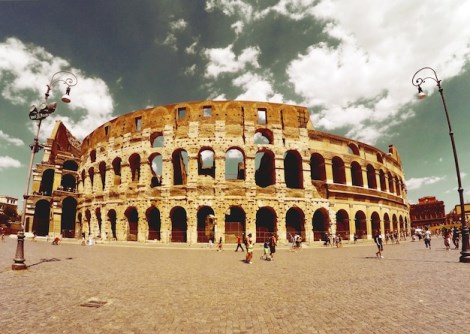10 Fascinating Facts about the Colosseum

The Colosseum is the largest amphitheater ever built.
It was constructed between 70 and 80 AD.
The original name of the Colosseum was the Flavian Amphitheater.
The giant structure covers an area of about 6 acres.
It could hold between 50,000 to 80,000 spectators.
The Colosseum was mainly used for gladiatorial contests and public spectacles.
The Emperor Vespasian, who commissioned the Colosseum, funded its construction using the spoils from the Jewish War.
The Colosseum was built mainly using concrete and stone.
It took over 9 years to complete the construction of the Colosseum.
The Colosseum has a complex system of underground tunnels and chambers which were used to transport animals, gladiators, and scenery.
The first ever games held at the Colosseum lasted for 100 days and included various forms of entertainment such as gladiator fights, mock naval battles, and animal hunts.
Wild animals such as lions, elephants, and bears were imported from Africa and other parts of the Roman Empire for the games.
The Colosseum had a retractable awning system known as the velarium, which could shield the spectators from the sun.
It is estimated that over 500,000 people and about a million animals lost their lives in the Colosseum.
The Colosseum also had a network of pipes and conduits for supplying water to the arena.
In the Middle Ages, the Colosseum was used as a fort, housing nobles and their families.
10 Fascinating Facts about the Colosseum part 2
The Colosseum suffered severe damage due to earthquakes and stone-robbers over the centuries.
The street that runs in front of the Colosseum is called Via dei Fori Imperiali, and it connects the Colosseum to the Roman Forum.
The Colosseum was partially restored in the 18th century by Pope Benedict XIV.
Today, the Colosseum is one of the most popular tourist attractions in Rome, visited by millions of people each year.
The Colosseum is featured on the Italian version of the five-cent euro coin.
It served as a model for many modern-day stadiums and arenas around the world.
Several films and TV shows, including Gladiator and Roman Holiday, have featured scenes filmed in or around the Colosseum.
The Colosseum is considered one of the Seven Wonders of the Modern World.
It is possible to visit the underground chambers and tunnels of the Colosseum on a guided tour.
Despite its size, the Colosseum was designed to be easily emptied in just a few minutes.
The Colosseum’s exterior was once covered in marble, which has been looted over the years.
The Colosseum was not only used for entertainment purposes but also for public executions.
Emperor Commodus, who ruled during the decline of the Roman Empire, was known for participating in gladiatorial fights at the Colosseum.
Pope Pius IX sanctioned the Colosseum as a sacred Christian site in 1749, as it was believed that early Christians were martyred there.
The Colosseum’s seating was divided into different sections for the social classes of Ancient Rome.
The Colosseum was heavily damaged by a massive fire in 217 AD.
The Colosseum underwent multiple restoration efforts in the following centuries by various popes and emperors.
It is estimated that the construction of the Colosseum required over 100,000 cubic meters of travertine stone.
The underground chambers of the Colosseum were used to house gladiators and wild animals before the games.
The Colosseum had a series of trapdoors and elevators used for special effects during the spectacles.
The design of the Colosseum allowed for efficient entry and exit of the spectators through its numerous arches and stairways.
Due to its historical and cultural significance, the Colosseum became a UNESCO World Heritage Site in 1980.
Vicious sea battles involving warships were recreated in the Colosseum by flooding the arena.
The Colosseum’s original bronze statues and monuments were looted over the centuries.
The Colosseum was the largest building of its time, standing at 48 meters tall.
The Colosseum was abandoned in the 6th century and became a quarry for various construction projects in Rome.
In 2000, the Colosseum was named one of the New7Wonders of the World in a global poll.
The underground hypogeum of the Colosseum was a complex system of rooms and tunnels where fighters and animals awaited their turns.
The Colosseum’s design provided excellent acoustics, allowing the spectators to hear the action in the arena clearly.

